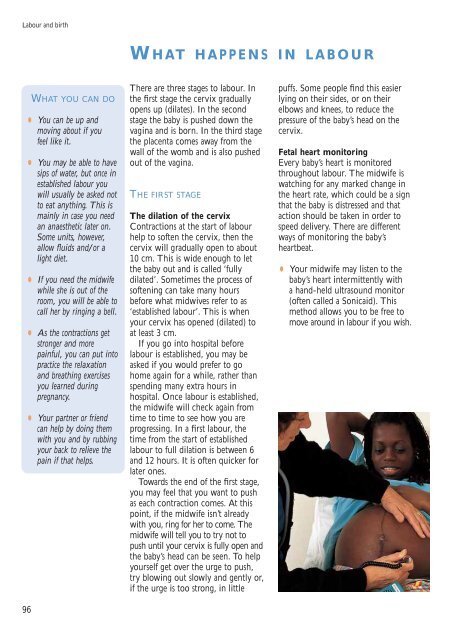here - Health Promotion Agency
here - Health Promotion Agency
here - Health Promotion Agency
Create successful ePaper yourself
Turn your PDF publications into a flip-book with our unique Google optimized e-Paper software.
Labour and birth<br />
W HAT HAPPENS IN LABOUR<br />
WHAT YOU CAN DO<br />
•<br />
96<br />
You can be up and<br />
moving about if you<br />
feel like it.<br />
• You may be able to have<br />
sips of water, but once in<br />
established labour you<br />
will usually be asked not<br />
to eat anything. This is<br />
mainly in case you need<br />
an anaesthetic later on.<br />
Some units, however,<br />
allow fluids and/or a<br />
light diet.<br />
•<br />
If you need the midwife<br />
while she is out of the<br />
room, you will be able to<br />
call her by ringing a bell.<br />
• As the contractions get<br />
stronger and more<br />
painful, you can put into<br />
practice the relaxation<br />
and breathing exercises<br />
you learned during<br />
pregnancy.<br />
•<br />
Your partner or friend<br />
can help by doing them<br />
with you and by rubbing<br />
your back to relieve the<br />
pain if that helps.<br />
T<strong>here</strong> are three stages to labour. In<br />
the first stage the cervix gradually<br />
opens up (dilates). In the second<br />
stage the baby is pushed down the<br />
vagina and is born. In the third stage<br />
the placenta comes away from the<br />
wall of the womb and is also pushed<br />
out of the vagina.<br />
THE FIRST STAGE<br />
The dilation of the cervix<br />
Contractions at the start of labour<br />
help to soften the cervix, then the<br />
cervix will gradually open to about<br />
10 cm. This is wide enough to let<br />
the baby out and is called ‘fully<br />
dilated’. Sometimes the process of<br />
softening can take many hours<br />
before what midwives refer to as<br />
‘established labour’. This is when<br />
your cervix has opened (dilated) to<br />
at least 3 cm.<br />
If you go into hospital before<br />
labour is established, you may be<br />
asked if you would prefer to go<br />
home again for a while, rather than<br />
spending many extra hours in<br />
hospital. Once labour is established,<br />
the midwife will check again from<br />
time to time to see how you are<br />
progressing. In a first labour, the<br />
time from the start of established<br />
labour to full dilation is between 6<br />
and 12 hours. It is often quicker for<br />
later ones.<br />
Towards the end of the first stage,<br />
you may feel that you want to push<br />
as each contraction comes. At this<br />
point, if the midwife isn’t already<br />
with you, ring for her to come. The<br />
midwife will tell you to try not to<br />
push until your cervix is fully open and<br />
the baby’s head can be seen. To help<br />
yourself get over the urge to push,<br />
try blowing out slowly and gently or,<br />
if the urge is too strong, in little<br />
puffs. Some people find this easier<br />
lying on their sides, or on their<br />
elbows and knees, to reduce the<br />
pressure of the baby’s head on the<br />
cervix.<br />
Fetal heart monitoring<br />
Every baby’s heart is monitored<br />
throughout labour. The midwife is<br />
watching for any marked change in<br />
the heart rate, which could be a sign<br />
that the baby is distressed and that<br />
action should be taken in order to<br />
speed delivery. T<strong>here</strong> are different<br />
ways of monitoring the baby’s<br />
heartbeat.<br />
• Your midwife may listen to the<br />
baby’s heart intermittently with<br />
a hand-held ultrasound monitor<br />
(often called a Sonicaid). This<br />
method allows you to be free to<br />
move around in labour if you wish.
















